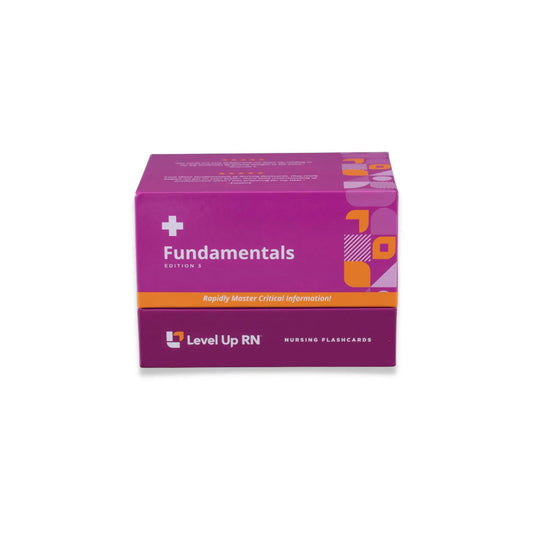Fundamentals of Nursing - Flashcards
This article covers electrolytes and electrolyte imbalances. You can follow along with our Fundamentals of Nursing flashcards, which are intended to help RN and PN nursing students study for nursing school exams, including the ATI, HESI, and NCLEX.
Additionally, the Med-Surg Nursing video series, which follows our Medical-Surgical Nursing Flashcards, offers an in-depth look at electrolytes and acid-base balance.
Calcium (Ca)
Calcium is critical for many body functions, including bone and teeth formation, muscle and nerve function, and blood clotting.
The normal range for calcium is 9 to 10.5 mEq/liter.
Hypercalcemia
Hypercalcemia is having too much calcium, which is anything over 10.5 mEq/L.
The causes of hypercalcemia include hyperparathyroidism, prolonged immobility, long-term corticosteroid use, and bone cancer.
The signs and symptoms of hypercalcemia include constipation, a decrease in deep tendon reflexes (DTRs), kidney stones, and lethargy.
Hypocalcemia
Hypocalcemia is having too little calcium, which is anything under 9 mEq/L.
Hypocalcemia may be caused by hypoparathyroidism, as well as decreased Vitamin D intake and diarrhea.
The signs and symptoms of hypocalcemia include positive Chvostek’s and Trousseau’s signs, muscle spasms, numbness and/or tingling in the lips and/or the fingers, as well as GI upset.
A positive Chvostek’s sign is an abnormal reaction to the stimulation of the facial nerve — when you tap on the cheek the muscle twitches.
A positive Trousseau’s sign is an abnormal reaction of the hand to pressure on the arm, for example when a blood pressure cuff is wrapped around it.
For a more in-depth look at medications and supplements that are used to treat and prevent electrolyte imbalances due to calcium, our Lab Values Study Guide & Flashcard Index is a list of lab values covered in our Lab Values Flashcards for nursing students and can be used as an easy reference guide.
Magnesium (Mg)
Magnesium is critical for muscle and nerve function, as well as aiding biochemical reactions in the body.
Magnesium has a normal range of 1.3 to 2.1 mEq/L.
Hypermagnesemia
Hypermagnesemia is having too much magnesium, which is anything over 2.1 mEq/L.
The causes of hypermagnesemia include kidney disease, as well as ingesting laxatives and antacids that contain magnesium.
Signs and symptoms of hypermagnesemia include hypotension (low blood pressure), lethargy, muscle weakness, and respiratory and cardiac arrest. It also may lead to a decrease in deep tendon reflexes (DTRs).
Hypomagnesemia
Hypomagnesemia is having too little magnesium, which is anything under 1.3 mEq/L.
The causes of hypomagnesemia include GI losses, diuretics, malnutrition, and alcohol abuse.
Signs and symptoms include dysrhythmias (irregular heartbeat (irregular/non-regular rhythm)), tachycardia, hypertension, tremors, and an increase in DTRs (the opposite of hypermagnesemia). Hypomagnesemia also puts the patient at the risk for seizures.
For a more in-depth look at medications and supplements that are used to treat and prevent electrolyte imbalances due to magnesium, our Lab Values Study Guide & Flashcard Index is a list of lab values covered in our Lab Values Flashcards for nursing students and can be used as an easy reference guide.
Potassium (K)
Potassium, critical for nerve function and the regulating of muscle and heart contractions, is a crucial lab value to know.
The normal range for potassium is 3.5 to 5 mEq/L.
An imbalance in potassium could lead to a cardiac arrest.
 K is for "K"ardiac; assess cardiovascular status!
K is for "K"ardiac; assess cardiovascular status!
Hyperkalemia
Hyperkalemia is having too much potassium, which is anything over 5 mEq/L.
The causes of hyperkalemia include diabetic ketoacidosis (DKA; also known as hyperglycemia), metabolic acidosis, the ingestion of salt substitutes, and kidney failure.
Signs and symptoms of hyperkalemia include dysrhythmias, muscle twitching and/or weakness, numbness and/or tingling, diarrhea, and confusion.
Hypokalemia
Hypokalemia is having too little potassium in the body, which is anything under 3.5 mEq/L.
The causes of hypokalemia include the use of diuretics (e.g., furosemide), as well as vomiting, diarrhea, diaphoresis (excessive sweating), and metabolic alkalosis.
Signs and symptoms of hypokalemia include dysrhythmias, muscle weakness, constipation and/or ileus (when the whole GI system peristalsis stops, or is “paralyzed”), hypotension, and a weak pulse.
For a more in-depth look at medications and supplements that are used to treat and prevent electrolyte imbalances due to potassium, our Lab Values Study Guide & Flashcard Index is a list of lab values covered in our Lab Values Flashcards for nursing students and can be used as an easy reference guide.
Sodium (Na)
Sodium maintains the body’s fluid balance and is critical for nerve and muscle functions.
Like potassium, sodium is a vitally important lab value to know. It's normal range is 136 to 145 mEq/L.
A fluid imbalance due to sodium could cause a neurological issue, which is why it is important to assess a patient’s neurological status if they have a sodium imbalance.
 Na is for Neurological; assess for changes!
Na is for Neurological; assess for changes!
Hypernatremia
Hypernatremia is having too much sodium, which is anything above 145 mEq/L.
The causes of hypernatremia include kidney failure, excess sodium intake, fever, and NPO (fasting).
Signs and symptoms of hypernatremia include muscle twitching and/or weakness, thirst, tachycardia, GI upset, edema (excess fluid), irritability or agitation, and coma.
Hyponatremia
Hyponatremia is having too little sodium, which is anything below 136 mEq/L.
The causes of hyponatremia include diuretics, kidney failure, diaphoresis, hyperglycemia (also known as DKA, mentioned above), heart failure, and fluid volume overload (dilutional hyponatremia).
Signs and symptoms of hyponatremia include confusion, altered mental status, tachycardia, hypotension, weak pulse, fatigue, nausea, vomiting, headache, and seizure.
For a more in-depth look at medications and supplements that are used to treat and prevent electrolyte imbalances due to sodium, our Lab Values Study Guide & Flashcard Index is a list of lab values covered in our Lab Values Flashcards for nursing students and can be used as an easy reference guide.



1 comment
bravo!!!educational and helps me with my Adaptive processes H-371:) I would like you to talk about acidosis and alkalosis symptoms for Respiratory and Metabolic. We had the test and I did not study that part like the exam symptoms were given and asked but no ABGs ranges then name based on the symptoms if its resp acidosis or metabolic alkalosis.